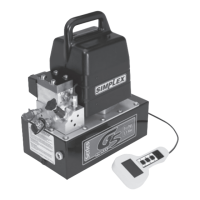••• 6 •••
5.1 POWER CONTROL SWITCHES
Remote pendant or shroud switches control as follows:
Congured with motor/valve control pendant:
ADVANCE = Press and hold switch to activate advance coil.
RETRACT = Press and hold switch to activate retract coil.
5.2 STARTING THE PUMP FOR THE FIRST TIME
1. Locate the valve control and make sure it’s in the “neutral” or “open” position.
2. Attach air line to the pump and open valve. Check for any leaks, repair as needed.
3. Shift the control valve to the closed, advance and retract position and look for movement in tool or cylinder.
Check for any leaks, repair as needed.
Bleeding the Hydraulic System - air can be removed from the system by fully advancing and retracting the
hydraulic cylinder several times with the pump elevated so its reservoir is higher than the cylinder. Single-acting
cylinders should be inverted and double-acting on their side with the hydraulic couplers pointed up. When the
trapped air is removed from the hydraulic circuit, the cylinder will advance and retract smoothly. Sluggish or jerky
cylinder action is usually the rst sign of air in the system.
Shift the lever to Advance position to activate ram or cylinder. To hold load, place lever into Neutral/Hold or turn off
pump. Move lever to retract position to release load.
CAUTION: Never operate the pump at 10,000 PSI (700kg/cm
2
) without ram movement for more than 1 minute
without shifting the control valve to neutral or turning off motor. Leaving the valve in the advance or retract position
without the piston rod moving will overheat the oil.
CAUTION: Never disconnect or connect any hydraulic hoses or ttings without rst unloading the ram, then unplug
the electrical cord of the pump and shift, or open all hydraulic controls several times to assure that the system has
been depressurized. If the system includes a gauge, double check the gauge to assure pressure has been released.
WARNING: Solenoid valves may not prevent load
movement between shifted positions of the valve when
used in systems to support live loads. Locking valves or
other load holding devices may be required to prevent
unintended load movement.
Retract
Advance
Solenoid valve stays in center
position until button is actuated.
3 Way Solenoid Valve
4 Way Solenoid Valve
2 Way Manual
3 Way Manual
4 Way Manual

